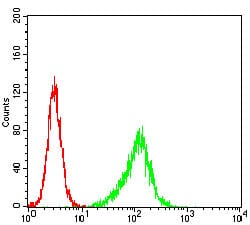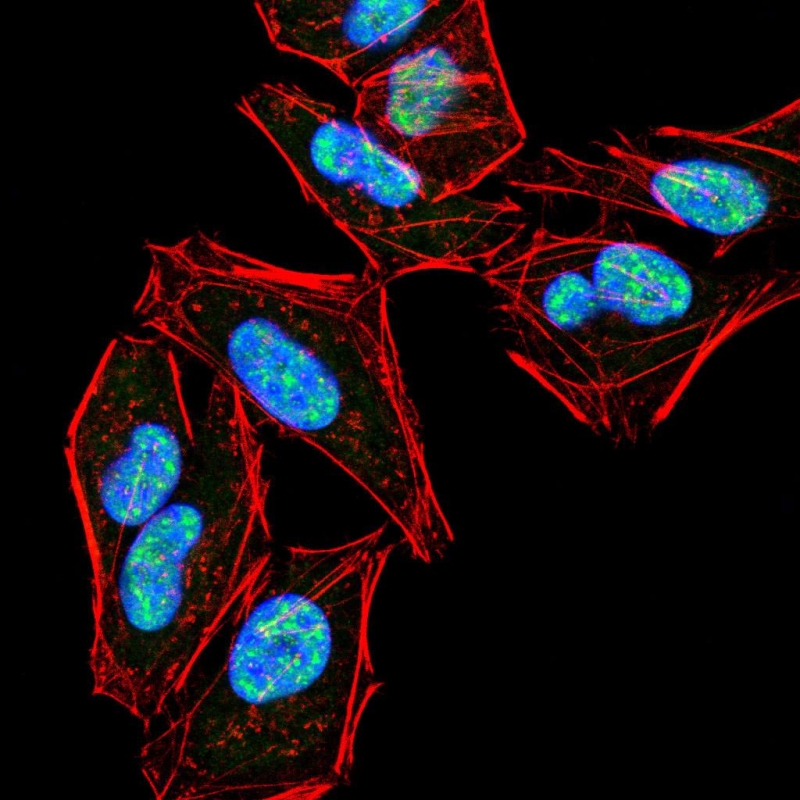



| WB | 1/500 - 1/2000 | Human,Mouse,Rat |
| IF | 咨询技术 | Human,Mouse,Rat |
| IHC | 咨询技术 | Human,Mouse,Rat |
| ICC | 1/200 - 1/1000 | Human,Mouse,Rat |
| FCM | 1/200 - 1/400 | Human,Mouse,Rat |
| Elisa | 1/10000 | Human,Mouse,Rat |
| Aliases | FCAS3; APLAID; PLC-IV; PLC-gamma-2 |
| Entrez GeneID | 5336 |
| clone | 3A8B6 |
| WB Predicted band size | 148kDa |
| Host/Isotype | Mouse IgG2b |
| Antibody Type | Primary antibody |
| Storage | Store at 4°C short term. Aliquot and store at -20°C long term. Avoid freeze/thaw cycles. |
| Species Reactivity | Human |
| Immunogen | Synthesized peptide of human PLCG2 (AA: phospho-Tyrosine 753 of human Phospholipase Cg2(cERDINSLpYDVSRMYV)). |
| Formulation | Purified antibody in PBS with 0.05% sodium azide. |
+ +
以下是关于PLCG2抗体的3篇参考文献示例,包含文献名称、作者及摘要概括:
1. **"PLCG2 mutations in antibody deficiency and immune dysregulation"**
**作者**: Ombrello, M.J. et al.
**摘要**: 研究揭示了PLCG2功能获得性突变与免疫失调综合征的关系,通过特异性抗体检测突变蛋白的表达水平,发现其异常激活导致B细胞信号通路紊乱,为免疫缺陷机制提供新见解。
2. **"Anti-PLCG2 monoclonal antibody inhibits rheumatoid arthritis progression in murine models"**
**作者**: Li, Z. et al.
**摘要**: 开发了一种靶向PLCG2的单克隆抗体,实验显示其能有效阻断下游炎症因子释放,显著减轻小鼠模型中的关节炎症,提示其在自身免疫疾病治疗中的潜力。
3. **"PLCG2 as a biomarker in chronic lymphocytic leukemia: antibody-based profiling study"**
**作者**: Wang, Y. et al.
**摘要**: 通过免疫组化和流式细胞术分析PLCG2在白血病细胞中的表达,证实其高表达与疾病进展相关,提出PLCG2抗体可作为预后评估的生物标志物工具。
*注:上述文献为示例,实际引用时需核实真实来源及准确性。建议通过PubMed或Web of Science以“PLCG2 antibody”或“PLCG2 signaling”等关键词检索最新研究。*
The PLCG2 antibody targets phospholipase C gamma 2 (PLCG2), a key enzyme in intracellular signaling pathways, particularly within immune cells. PLCG2 is a member of the phospholipase C family, which hydrolyzes phosphatidylinositol 4.5-bisphosphate (PIP2) into diacylglycerol (DAG) and inositol 1.4.5-trisphosphate (IP3), critical secondary messengers regulating calcium release and protein kinase C (PKC) activation. Expressed predominantly in hematopoietic cells, PLCG2 plays a vital role in B-cell receptor (BCR) and Fc receptor (FcR) signaling, influencing immune responses, cell proliferation, and differentiation.
PLCG2 contains distinct domains, including SH2. SH3. and catalytic regions, enabling interactions with tyrosine-phosphorylated proteins like Syk and receptor tyrosine kinases. Dysregulation of PLCG2 is linked to immune disorders. Gain-of-function mutations are associated with autoinflammatory diseases (e.g., PLAID, APLAID), while loss-of-function variants may contribute to immunodeficiency.
PLCG2 antibodies are essential tools for studying its expression, activation, and localization in immune cells. They are used in techniques like Western blotting, immunohistochemistry, and flow cytometry to investigate its role in pathological mechanisms or therapeutic targeting. Research on PLCG2 antibodies also aids in developing diagnostic biomarkers and tailored therapies for immune-related conditions.
×